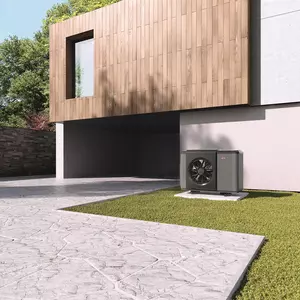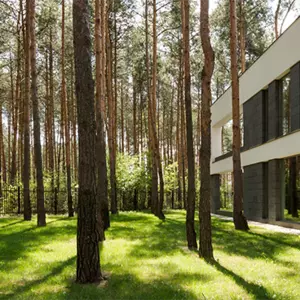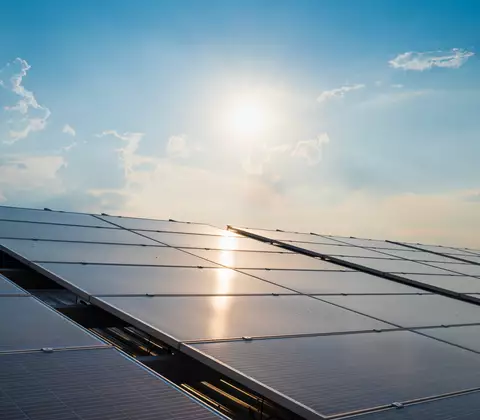
Smart use of energy to reduce energy costs
How to cut costs with solar energy
Solar energy can be used in various ways in the household. Solar energy, which of course free, can be converted into electricity in detached houses with the help of solar cells or used in the form of solar thermal energy to generate heat directly. The option that makes the most sense will depend on a number of individual factors, which we will examine in more detail in this article.
What is solar energy and how can it be used properly?
The sun is considered to be an inexhaustible source of energy and generates more energy per second through nuclear fusion than we could ever consume. Solar energy reaches us in the form of electromagnetic radiation. Chemical processes within the solar collectors make the solar radiation usable for us in the form of heat and/or light.
The most important forms of solar energy:
- Photovoltaic modules for power generation
- Heat generation through solar thermal energy
- Chemical energy
While photovoltaic systems converts light into electricity with the help of solar cells, solar thermal energy systems uses heat energy that is absorbed by collectors and transferred to a heating system or a heat storage tank. A third version is solar energy which can be used in chemical form, similar to how plants use photosynthesis to convert sunlight into chemical energy in order to grow. We then use this chemically stored solar energy indirectly when we eat plants or fruits or burn wood.
How much of Germany’s energy mix is covered by solar energy?
The use of renewable energies has risen sharply in Germany over recent years. In private households, photovoltaics in particular led to a rapid increase in installed capacity, due in no small part to the lavish feed-in tariff for solar power. The use of solar power generated at home has now become a priority for many households.
In March 2022, more than 2.2 million photovoltaic systems were installed in Germany, reaching a nominal capacity of 58,400 megawatts1. Renewable energies accounted for 4.2% of heating energy in 20212.
Find an installer now!
Find competent WOLF heating engineers in your area.
How does solar energy work in detail?
Solar thermal: brief explanation
You need suitable collectors to use solar thermal energy. Ideally, these should be installed on the roof to provide effect support for heating and DHW heating. The collectors come in two main designs:
Flat-plate collectors are less costly to buy.
Tube collectors usually deliver a greater yield.
All solar collectors work on the same principle: The energy of the sun's rays is “captured” in the form of heat on the dark collector surfaces.
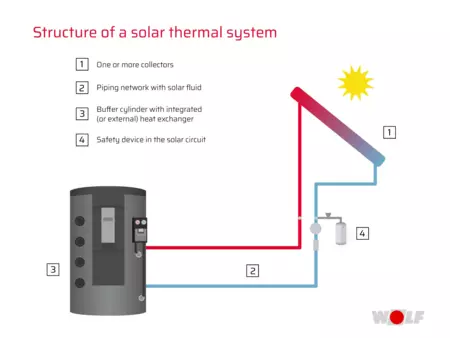
The solar fluid circulating inside the collectors (a mixture of water and antifreeze) absorbs the heat and transfers it to the heating system or a buffer cylinder via a heat exchanger. Tube collectors are more expensive than flat-plate collectors, but have a higher efficiency of up to 30%. They are particularly useful if the amount of space on the roof is very limited and not enough flat-plate collectors can be installed. Modern flat-plate collectors are also very efficient and much cheaper. If there is enough space available, they are usually the best choice.
Photovoltaics: brief explanation
In contrast to solar thermal technology, a PV system uses far more complex technology to convert sunlight into electromagnetic energy. As a result, in a photovoltaics system, it is the light yield that is the crucial factor, not the heat of the sunlight.
For this reason, solar thermal systems are an extremely efficient way to generate electricity, even on colder days, as long as it is bright enough. The advantage of modern solar cells is that they can even convert diffuse sunlight into electricity (e.g. in cloudy weather or if the orientation of the panels is sub-optimal).
Which is more cost-effective: Solar thermal technology or photovoltaics?
The most important issue to consider is how you intend to use the energy. If you mainly want to cover some of your energy consumption, photovoltaics might be an interesting option. This can be used to operate an efficient heat pump more cost-effectively to reduce your heating costs. If, on the other hand, you are more interested in feeding energy directly into the heating system, solar thermal technology is often a more effective and cheaper option because the systems involved are cheaper to purchase and install However, rising electricity prices are making solar power generation systems an increasingly attractive option for home owners. It very much depends on your individual requirements when it comes to the overall heating and energy plan of the building in question.
Of course, the length of time that you will use your solar thermal or photovoltaic system for will also play a role when calculating costs. The average service life for solar thermal technology can be up to 25 years. Photovoltaics systems tend to last for around 20 to 30 years, depending on which type of solar cells are involved. There are no additional costs for disposal, as the manufacturers are obliged to take back the systems. You will only need to pay for the dismantling and safe transport of the modules.
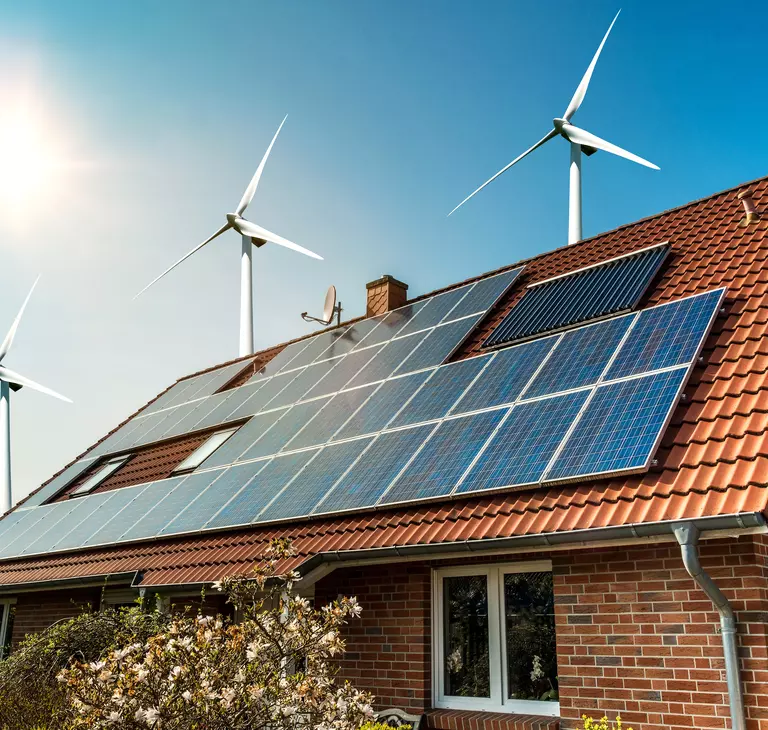
Making the best possible use of solar energy
Regardless of whether you prefer photovoltaics or solar thermal energy, a number of factors will play an important role in the planning process. There are a few issues to consider to make sure that you are using solar energy efficiently.
Location: Is the amount of solar radiation at the location sufficient? Consult the solar map or the solar atlas of your town or municipality. This online tool will indicate suitable locations for solar power systems. All you have to do is enter your address. The solar map uses a colour code system to show you whether your roof is a suitable location for a solar thermal system.
Watch out for shady areas. Tall buildings, trees or landscape features can create shade. The amount of shade can vary depending on the season.
Roof pitch Solar energy can normally be generated on flat roofs as well as on vertical facades. The question is how high the yield of the collectors or solar cells is compared to the work involved. Roof pitch is a more important factor for photovoltaics than for solar thermal technology.
System size: You should choose a system that is large enough to handle the energy needs of the household and, if applicable, the heating system. Choosing a system that is too large will result in unnecessary additional costs, while a system that is too small will probably not reduce your heating or electricity costs by as much as you would like.
Overall energy supply: Secondary factors like your insulation and the condition of the house also have an impact on the energy efficiency of your photovoltaic or solar thermal system.
Listed status: Regulations designed to protect listed buildings can torpedo your project. You should always check what these regulations are well in advance if you are planning to update an existing building.
Cylinders have a vital role to play when using solar energy
The so-called solar constant describes the amount of energy that reaches the earth from the sun in watts per square metre3. The average global value is 1,367 W/m². Solar yield can vary based on to the fluctuations in the irradiation angle and the strength of the sun’s rays as well as the position of the solar thermal system. Atmospheric fluctuations and the weather can also cause the solar yield to fluctuate. The sun does not shine at night and daylight hours are limited in winter. To add to that, the angle of incidence is no longer optimal for solar energy purposes in winter months. That’s why homeowners need to use the available energy as efficiently as possible. Because most people do not need to use energy at noon when the weather is best, energy storage is indispensable.
The shift from homeowners feeding solar energy into the grid to using it themselves (e.g. to power a heat pump) has increased the need for batteries. The best option when using solar thermal technology is to install a buffer cylinder for DHW heating and/or central heating backup.

Top advice from WOLF
If you are looking for an efficient heat pump for your existing building or a new build, you should seek in-depth advice. Correct dimensioning and careful planning are crucial for efficient heating. The experts at WOLF will be happy to help you.
Conclusion: Is using solar energy worth it?
Purchasing a solar thermal system is a large investment, especially if you buy a photovoltaics system. But a good solar thermal system will also be expensive. It is important to integrate it into a good overall energy concept that takes all of the essential factors into account - from the building’s insulation through to the heating system and how individuals in the household use energy.
When using a modern heat pump (such as the WOLF CHA Monoblock), solar thermal technology can reduce heating costs when combined with a buffer cylinder. Combining a photovoltaic system with a heat pump can be a highly efficient option as it can make DHW heating completely free, especially in summer. We recommend an individual consultation and using all of the subsidies you can, whichever path you go down. Feel free to contact the experts on the WOLF hotline for detailed advice.
